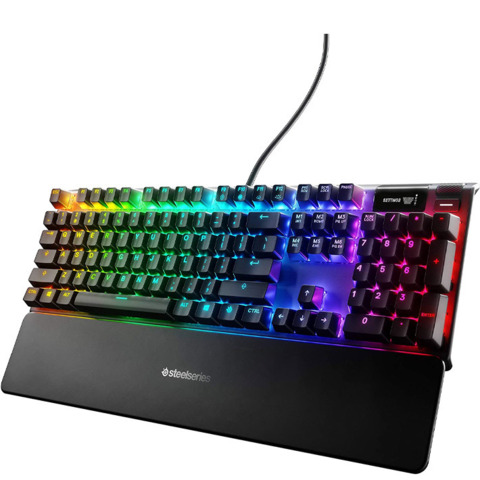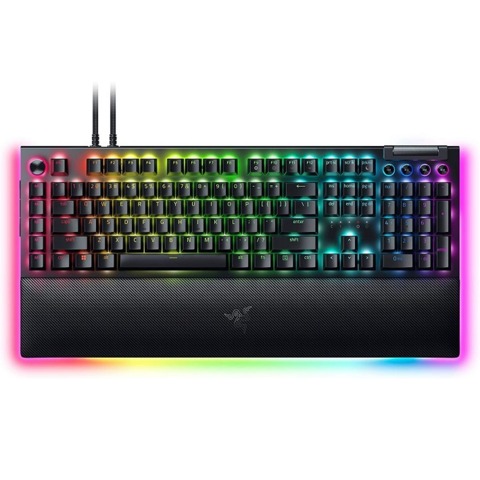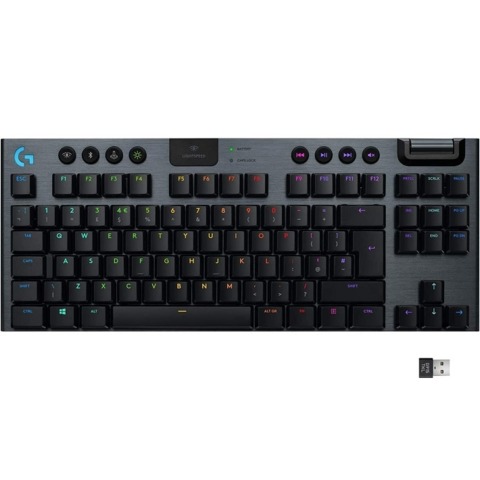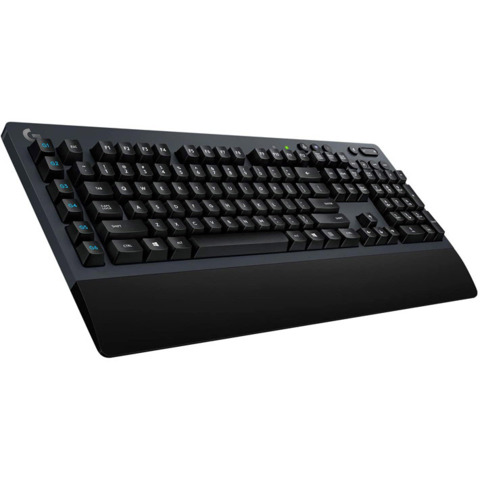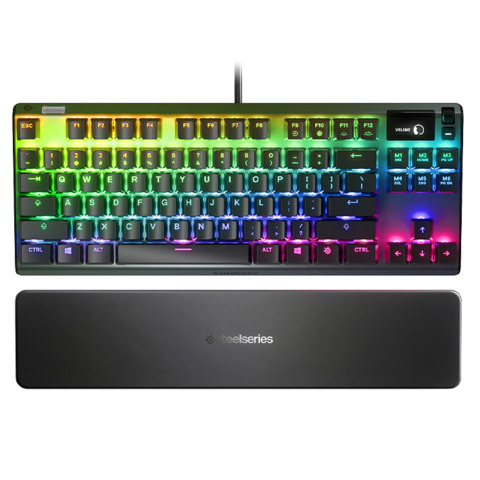Choosing a gaming keyboard can be more complicated than you might think. Some models are designed to be durable, robust landmarks on your desk, whereas others are streamlined to take up as little space as possible. Then there are specs to consider like switches, input latency, and wired vs wireless connections, not to mention all the extra features that keyboards tend to come with like multimedia keys and RGB lighting. There is a lot to consider.
To help make the process easier, we’ve put together a list of our favorite gaming keyboards in 2024. While our top pick, the SteelSeries Apex Pro, can handle just about any scenario, you’ll find plenty of other options in various categories like the best TKL, wireless, and budget options, just to name a few.
Since this is a keyboard-focused list, we also took some time to focus on one of the most important factors when choosing a keyboard: the switches. Scroll down below the list for details on the differences between various keyboard switches.
Looking to complete your gaming keyboard and mouse combo, or just want more gaming peripherals to shop for? Check out our picks for the best PC gaming headset and best gaming mouse. And if you also want to ditch the mouse and keyboard sometimes, take a look at our list of the best PC controllers. Finally, if you have a Steam Deck, make sure to check out our roundups of the We also have a list of the best Steam Deck games and best Steam Deck accessories.
Editor’s Note: Article updated on April 25, 2024
SteelSeries Apex Pro
Specs
Battery life: N/A
Connectivity: Wired USB
Layout: Full size
Switches: OmniPoint 2.0 Adjustable HyperMagnetic switches
Keycaps: Double Shot PBT Keycaps
Backlight: Dynamic Per Key RGB
OS compatibility: Windows, MacOS, PlayStation, Xbox
Pros
- Fast input response
- Adjustable per-key actuation points
- USB passthrough
- Integrated OLED display for swapping settings or monitoring PC info
- Includes wrist rest
- Lots of customization via the desktop app
Cons
- Limited feature support on MacOS, PlayStation, and Xbox
- No Linux support
The SteelSeries Apex Pro was once a purely high-end option, but thanks to price drops, is now a much more affordable device packed with excellent features and specs. The big draw is its adjustable Hall effect switches. Each key’s actuation point (how far you have to press a key before it’s activated) can be customized to match your preferences or in-game needs. For example, if you want your number row to have short actuation so your abilities fire off quickly, you can do that.
The SteelSeries Apex Pro sports tons of other great features, like an integrated OLED that lets you adjust the keyboard’s settings, USB passthrough, and even support for PlayStation and Xbox.
We’re calling out the full-size Apex Pro as the best gaming keyboard overall, but there are smaller variants for those who want a slimmer model to save desk space, including our favorite TKL keyboard the Apex Pro TKL, and the super-compact Apex Pro Mini.
Razer BlackWidow V4 Pro
The Razer BlackWidow V4 Pro isn’t just one of the newest keyboards on this list–it’s also one of the most expensive. But if you’re willing to up your budget, you’ll get a laundry list of high-end features that make the V4 more than worthy of the iconic BlackWidow name.
As usual, the BlackWidow V4 Pro was built to the high standards of Razer, which means you’re getting doubleshot ABS keycaps, per-key RGB lighting, and even a magnetic plush wrist rest with an underglow effect. But what makes the V4 Pro so compelling it its set of macro keys and the command dial.
These customizable components make it easy to quickly control your on-screen action without having to wade through a series of menus. All told, you’ll have eight macro keys along with four dedicated media keys–so you should have no problem programming the keyboard to fit your needs.
Toss in an aluminum chassis, the option for yellow or green switches, and USB passthrough, and it’s easy to see why the BlackWidow V4 Pro is an excellent, feature-rich gaming keyboard. With a premium build and great comfort/feel, the BlackWidow V4 Pro is worth considering if you don’t mind spending a lot on a gaming keyboard. The only downsides here are that it’s only available as a wired keyboard and the price is very steep.
Logitech G915 Wireless
Specs
- Battery life: 30 hours
- Connectivity: 2.4Ghz; Bluetooth; wired USB
- Layout: Full size
- Switches: Low Profile GL mechanical switches
- Backlight: Per-key RGB
- OS compatibility: Windows, MacOS, Android, iOS
Pros
- Five programmable macro keys
- Multi-device connection support
Cons
The Logitech G915 Wireless is a high-performing keyboard that doesn’t need cables to keep up with the competition. Thanks to Logitech’s Lightspeed wireless tech, you’ll get responsive performance regardless of what you’re playing.
Featuring a design that’s constructed with aircraft-grade aluminum, five G-keys (macro keys), the availability of several switch types, and a media controller, Logitech didn’t cut any corners with the G915 Wireless. Best of all, you’ll get 30 hours of runtime out of the keyboard before needing a recharge.
The keyboard connects via the included USB receiver or Bluetooth, allowing you to connect to multiple devices at once. The G915 is available in full-size and TKL configurations, both of which offer incredible performance despite their lack of wires.
Logitech G613
Specs
- Battery life: Up to 18 months
- Connectivity: Bluetooth; wired USB
- Layout: Full-size
- Switches: Romer-G Tactile
- Backlight: N/A
- OS compatibility: Windows, MacOS, Android, iOS
Pros
- Affordable
- Varied OS and device support
- Great battery life
Cons
- Low-end specs and features
Wireless mechanical keyboards are hard to come by, since there are so few options available. That’s not the only reason why we recommend the Logitech G613, though. Input latency is at the top of concerns, but that’s been largely solved as seen with wireless gaming mice, and Logitech adapts its « Lightspeed » tech found in its mice for the G613. It’s also a fantastic budget gaming keyboard.
The G613 is a full-size keyboard in every sense. It features a built-in plastic wrist rest, which is handy, but not detachable. There are six programmable macro keys on the left side of the keyboard and a suite of media controls at the top-right, too. Most importantly, the G613 stands among the great mechanical keyboards out there because of its fast response and accurate mechanical switches. It only comes with Romer-G tactile switches, which isn’t so bad because these provide all the benefits of a mechanical switch like smooth, consistent keystrokes.
While you’ll need to stock up on AA batteries, the G613 is quite efficient, lasting up to 18 months according to Logitech–it’s so efficient, we’re not even talking in hours anymore. It’d be pretty annoying to swap out batteries for a keyboard every few months, so this is key. A reason why battery life last this long is because one common feature has been left behind: backlit keys. Keys are painted in a vibrant white that helps visibility, but of course it’s not the same as proper backlighting.
Considering its feature set and the fact that it’s wireless, the Logitech G913 is a bargain. Plus it’s almost always on sale nowadays. The prospect a wireless gaming keyboard may not be as appealing as a wireless mouse (you’re not constantly moving a keyboard around and dragging a cord after all), but those who want to cut the cord without sacrificing keyboard quality have a great option here.
Corsair K100 Air Wireless
Specs
- Battery life: 50 hours
- Connectivity: 2.4Hz Wireless; Wired USB
- Layout: Full size
- Switches: Cherry MX Ultra Low Profile Tactile
- Backlight: Per-key RGB
- OS compatibility: PC, Mac, Xbox
Pros
- Ultra-low profile design
- Great battery and features for the size
- Xbox support
Cons
- Expensive
- Size may not be for everyone
There’s low-profile, and then there’s the Corsair K100 Air Wireless. Designed with keycaps that resemble laptop keys, the Corsair K100 Air Wireless is radically smaller than most other keyboards on this list, and it’s a great option for someone that wants a board that both functions at a high level yet looks incredible on their desktop.
Cherry MX Ultra Low Profile mechanical switches are the star of the show, offering the short activation distance of just 0.8mm. Each key also features RGB backlighting with adaptive brightness that varies based on the light levels in your room. And beyond your standard QWERTY keys, you’ll also benefit from dedicated media keys and an aluminum volume roller.
You won’t have to worry about running out of juice for the wireless keyboard either, as it can run for 50 hours on a single charge–and that bumps all the way to 200 if you turn off the backlights. All these features come at a price, and the K100 Air gets pretty close to $300. But if you need something sleek with tons of functionality, it simply can’t be beat.
SteelSeries Apex 3 TKL
Specs
- Battery life: N/A
- Connectivity: USB
- Layout: TKL
- Switches: SteelSeries Whisper-Quiet Switches
- Backlight: 8-zone RGB
- OS compatibility: Windows, MacOS, Xbox, PlaySation
Pros
- Quiet typing
- IP32 Water-resistant
- Works on PlayStation and Xbox
Cons
- Limited features and specs compared to other Apex models on this list
If you’re for a solid gaming keyboard for under 50 bucks, the SteelSeries Apex 3 is a wonderful option. The Apex 3 features tactile switches that barely make a sound when pressed, so it’s a great option for those who want high-quality switches without the constant clattering while typing.
Even at this price point, the Apex 3 still has some lovely features, including anti-ghosting tech, RGB illumination that’s customizable across eight zones, a water-resistant design, media keys, and a volume roller. It also has a cable management system that can help keep your desk looking clean. The Apex 3’s keys are graded for 20 million clicks, so you’re still getting a gaming keyboard that is built to last.
SteelSeries Apex Pro TKL
Specs
- Battery life: N?/A
- Connectivity: 2.4Ghz; Bluetooth 5.0; Detachable USB-C
- Layout: TKL
- Switches: OmniPoint 2.0 Adjustable HyperMagnetic switches
- Keycaps: Double Shot PBT Keycaps
- Backlight: Per-key RGB
- OS compatibility: Windows, MacOS, Xbox, PlayStation
Pros
- HyperMagnetic Switches with customizable per-key actuation points
- Rapid Trigger key activation/deactivation
- Wrist rest
- OLED Smart display
- Console support
Cons
- The lack of num pad keys and slightly more cramped layout may not be for everyone.
As mentioned earlier, the SteelSeries Apex Pro comes in multiple size options, so if the full-size variant of our favorite gaming keyboard is too big, then a smaller variant like the Apex Pro TKL is worth considering. This version shares all the same core features as its full-size sibling but uses an 80% or « TKL » (tenkeyless) layout that lacks the num pad, which makes it our top recommendation for keyboards of this size. As you’ll see from our other picks, there are multiple keyboard sizes smaller than the traditional 96-key layout. TKLs are great for players who want to maximize desk space but want to keep the arrow keys and F row that are commonly removed from smaller-sized options.
If you’re keen on the Apex Pro’s looks and features, but the TKL model still isn’t quite small enough, the Apex Pro Mini is also worth considering.
Asus Strix Scope II 96 Wireless
Specs
- Battery life: 1500 hours
- Connectivity: 2.4Ghz; Bluetooth; wired USB
- Layout: 96% (full key)
- Switches: ROG NX Snow linear switches or ROG NX Storm clicky switches
- Keycaps: ROG PBT doubleshot keycaps or UV-coated ABS keycaps
- Backlight: RGB
- OS compatibility: Windows
Pros
- Full 96-key layout on an 80% keyboard size
- Comes with wrist rest
- F row keys pre-programmed for Xbox Game bar controls
Cons
- Non-traditional key layout is more cramped than other keyboards of similar size and functionality
- Windows-only
Smaller keyboards are great for cramped desks or players who need a lot of table space for big mouse movements, but they come with tradeoffs like missing keys and non-traditional layouts that won’t work for everyone. Luckily, the Asus Strix Scope II 96 Wireless is one of the few gaming keyboards to offer the full key layout in a smaller form factor. The Strix Scope II 96 Wireless is classified as a « 96% » keyboard, which means it features the full 96-key layout found on standard-sized gaming keyboards–plus media controls and additional multi-function buttons–with dimensions closer an 80% frame. To achieve that trimmer design, the layout is tweaked, and key size and spacing are more cramped compared to both 80% and full-sized keyboards alike, but it’s not a drastic difference.
ASUS ROG Azoth
Specs
- Battery life: 2000 hours
- Connectivity: 2.4Ghz; Bluetooth; wired USB
- Layout (plus size?): 75%
- Switches: ROG NX mechanical switches
- Keycaps: ROG PBT Doubleshot Keycaps
- Backlight: Per-key RGB
- OS compatibility: Windows, MacOS
Pros
- Lots of customization
- Multiple ergonomic tilt positions
- Integrated OLED screen displays system information and other data
- Windows and Mac support
Cons
- OLED display and RGB backlight do not work with 2.4Ghz mode.
- Customization software is Windows-only
75% keyboards are where things start to get really small, squeezing in all the keys found on TKL models to an even tinier chassis. Luckily, these slim devices include many of the same features as their larger counterparts, and the ASUS Azoth in particular offers some of the most customization for a keyboard of this category. The Azoth uses hot-swappable ROG NX switches, and each key can be customized with programmable macro functions and per-key RGB backlighting in the Armoury Crate desktop app. The keyboard offers multiple connection types, including 2.4Ghz wireless, Bluetooth, and wired USB on Windows and MacOS. Unfortunately, the integrated OLED display and RGB backlighting only work while using the keyboard in Bluetooth or wired USB modes, and the customization software only works on Windows. Such restrictions are common on other wireless keyboards, but worth keeping in mind for Mac users and competitive players that prefer 2.4Ghz wireless connections.
Wooting 60HE
Specs
- Battery life: N/A
- Connectivity: Braided USB cable
- Layout: 60%
- Switches: Lekker Linear60 Hall effect switches
- Keycaps: ANSI PBT keycaps
- Backlight: RGB
- OS compatibility: Windows, MacOS, Linux
Pros
- Hall effect switches with customizable actuation points
- Rapid Trigger key activation/deactivation
- Low
- Customization software compatible with all PC operating systems
- Portable design
Cons
- Limited availability
- Highest performance mode disables RGB
Wooting’s 60HE does everything you’d want from an ultra-compact gaming keyboard for Windows, Mac, or Linux. The 60% key layout makes for a small footprint on your desk, and the included carrying strap and durable, liquid-resistant materials make it super portable. The smaller size doesn’t affect its performance at all–in fact, the Wooting 60HE packs hard-to-find features that make it one of the fastest and most accurate gaming keyboards available. The keyboard sports linear Lekker Hall effect switches with customizable actuation points between 0.1mm and 4mm–which makes for fast key activation–and uses parallel per-key scanning to read inputs, which is more accurate than the matrix scanning often used on other keyboards. The Wooting 60HE also has an optional « Tachyon mode » which speeds up analog per-key scanning to less than 1ms per ms. While this mode disables the keyboard’s RGB backlighting effect, that’s a fair tradeoff for even better accuracy and lower input latency.
The 60HE’s specs are impressive, and easily make it one of the best-performing keyboards of any size, but its baseline ergonomics are a common complaint. A wrist pad is available as an additional purchase that mitigates this issue, but that just makes the already expensive keyboard even more costly. That drawback is exacerbated by Wooting’s shipping methods. Wooting is a small company that operates on batch-based distribution, meaning it could take several weeks for your order to arrive. However, if you’re willing to pay and deal with potentially long shipping times, you’ll be hard-pressed to find a better-performing keyboard in this category.
Keychron Q6 Max
Specs
- Battery life: 180 hours
- Connectivity: 2.4Ghz; Bluetooth; Wired USB
- Layout: Full size
- Switches: Hot-swappable Gateron Jupiter switches (Linear, Clicky, Tactile)
- Keycaps: double-shot PBT KSA keycaps or double-shot PBT OSA side-printed shine-through keycaps
- Backlight: South-facing RGB LEDs
- OS compatibility: Windows, Mac, Linux
Pros
- Super-low input latency for wired and 2.4Ghz connections.
- Great for gaming and typing.
- Quieter than other mechanical keyboards.
Cons
- Lowest input latency mode not available over Bluetooth connections.
- Downward-facing RGB backlighting is less visible on standard keycaps.
Keychron makes great-looking keyboards that excel at both gaming and general use on Windows, Mac, and Linux, and their latest model, the Keychron Q6 steps up the game with one of the company’s most durable metal designs yet. That said, the reason the Keychron Q6 takes this category is thanks to its super-low input latency and high accuracy, which it achieves in part thanks to its 1000Hz polling rate and N-KKRO over wired or 2.4Ghz wireless connections. While other picks on this list offer similar low-latency performance to the Keychron Q6 (most notably the Wooting 60HE), its quality extends to a broader range of use cases than just gaming–but it’s an incredible option for gaming, too. While we’re recommending the full-size Keychron Q6 Max, the keyboard comes in multiple sizes, including 96%, 80%, 75%, 60%, and TKL models, and all deliver the same high-speed performance and customization features.
8BitDo Retro Keyboard
Specs
- Battery life: 200 hours
- Connectivity: 2.4Ghz, Bluetooth, wired USB
- Layout: TKL
- Switches: Kailh Box White V2
- Keycaps: Double-shot SA profile ABS keycaps
- Backlight: No
- OS compatibility: Windows, Android
Pros
- Classic design
- Multi-device connections and quick-swapping
- Additional module with programmable Super Buttons (all models) and Super Stick (C64 model-only)
Cons
- No backlighting on keys
- Doesn’t support Mac, iOS, or Linux.
While the 8BitDo Retro Keyboard sports a classic color scheme old-school console gamers will appreciate, it’s also another excellent budget-friendly choice. Like 8BitDo’s controllers, the Retro Keyboard packs features and specs you’d normally expect on models that cost two or three times as much, at least, including programmable keys and the ability to connect to multiple devices at once via Bluetooth, 2.4Ghz, or wired USB, and hot-swap between them with the press of a switch. The 8BitDo retro mechanical keyboard is currently available in two models, one based on the US NES and the other on the original Japanese Famicom. Both models include the optional Super Buttons attachment, which adds two large, programmable buttons you can use for games, macros, and more. However, 8BitDo is also launching a new model based on the Commodore 64 that adds an arcade stick to the button module, which could make this the ideal keyboard for playing classic arcade and console games on PC.
Keyboard switches, explained
Different types of switches will appeal to different and whether you’re going with a Cherry MX switch like Cherry MX Red or Cherry MX Blue, there are plenty of keyboards worth your time. It can get confusing quickly, especially if you can’t test these keyboards yourself and truly tell the difference with your own fingers. Thankfully, it’s easy to understand exactly what you’ll be getting if you understand the terminology.
First off, linear versus tactile switches keys. Linear means there is no physical feedback mechanism to indicate when a keystroke is registered. It’s smooth, relatively quiet, and preferred for rapidly tapping on keys. Tactile means there is a bump or click to indicate you’ve hit the actuation point; it’s louder, but some prefer having physical feedback for keystrokes. It really comes down to preference. Actuation point is the distance at which a keystroke is registered; a shorter distance means you don’t have to press the key down as far, but can lead to errant inputs. Actuation force is, well, the force needed to press the key down. Of course, there are all the quality-of-life considerations to think about, too, like multimedia keys, whether you want a programmable key row and such.
While Cherry has been the long-time dominant manufacturer of mechanical switches, some gaming peripheral brands have started making their own proprietary mechanical switches for their keyboards, namely Razer and Logitech. For a brief overview of the most common mx switches, see below:
- Cherry MX Red Switches: Linear
- Cherry MX Blue Switches: Tactile and Clicky
- Cherry MX Brown Switches: Tactile with a Bump
- Cherry MX Speed Switches: Linear with a very short actuation point
- Romer-G Linear Switches: Linear
- Romer-G Tactile Switches: Tactile with a Bump
- Razer Yellow Switches: Linear
- Razer Orange Switches: Tactile with a Bump
- Razer Green Switches: Tactile and Clicky
- Steelseries OmniPoint Adjustable Switches: Linear with adjustable actuation point



